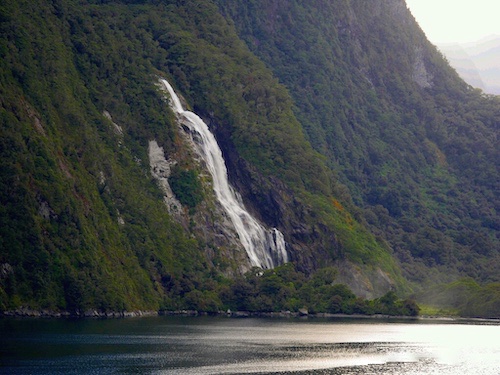
Fiordland National Park is a World Heritage Site and includes Milford, Dusky and Doubtful Sounds. Milford Sound was described by Rudyard Kipling as the Eighth Wonder of the World; take a scenic flight over it and you will understand why. Some of the fiords can be explored by kayak but if you’d like to see the less accessible fiords, eco-tours can be arranged. Carved by glaciers over 100,000 years the landscape is one where waterfalls cascade hundreds of metres into deep black fiords; where ancient rainforest untouched by man clings to mountains and where shimmering lakes and granite peaks look as they did a thousand years ago. The English called them sounds but really these are fiords, the same process that created the fiords in Norway. On our cruise we visited three of the most famous sounds, Milford, Doubtful and Dusky sounds.

This is a map of Fiordland National Park, showing the location of Milford, Doubtful and Dusky sounds.


















Situated on the west coast of the South Island, Milford Sound is a fusion of spectacular natural features with amazing visual cues around every corner. Milford Sound is named after Milford Haven in Wales, while the Cleddau River which flows into the sound is also named for its Welsh namesake. The Māori named the sound Piopiotahi after the thrush-like piopio bird, now extinct. Piopiotahi means “a single piopio”, harking back to the legend of Māui trying to win immortality for mankind – when Maui died in the attempt, a piopio was said to have flown here in mourning. The Bowen River is a river in northern Fiordland, New Zealand. The river runs south for 8 km, before flowing from a hanging valley to become the 162 m Lady Bowen Falls, and draining into the head of Milford Sound. The falls are named for Diamantina Bowen, wife of George Bowen, the fifth Governor of New Zealand.






A fiord is defined as a u-shaped glacier-carved valley which has been flooded by the sea. The fourteen fiords that fringe this south-west corner of the South Island were 100,000 years in the making, with the final details added during the most recent ice age just 10,000 years ago. The Maori attributed the creation of the fiords to a giant stonemason called Tute Rakiwhanoa, who hued out the steep sided valleys with his adzes. You can still see the effect of the glaciers or of you prefer, the marks of his Adze. On all sides of the fiords, spectacular waterfalls tumble incessantly as the region’s plentiful rainfall finds its way to the sea. With its rugged peaks, verdant rainforest and twisting, hidden inlets, Doubtful Sound will take your breath away. Home to abundant wildlife you may see bottlenose dolphins and fur seals at play, or catch a glimpse of a rare Fiordland Crested Penguin. 10 times larger and 3 times longer than Milford Sound, Doubtful Sound has three distinct, twisting arms, steep sided mountains clad with dense rainforest and several islands. At 421 metres, Doubtful Sound is the deepest of New Zealand’s fiords. It’s a haven for nature, with resident bottlenose dolphins, fur seals and penguins. Created by massive glacial forces and subject to one of the world’s highest rainfall levels, the fiord is home to fascinating and rare wildlife on land as well as above and below the water.









Dusky Sound, the largest fiord in New Zealand, is situated on the west coast of the South Island. It was first sighted on 13 March 1770 by Captain Cook who named it Dusky Bay because of its sombre aspect. During his second voyage to New Zealand Cook entered the Sound on March 26, 1773 and remained there until May 11, 1773, thoroughly exploring and charting the Sound. The wealth of bird life impressed him and his place names tell their own story; Shag River; Seal Rock; Curlew, Shag, Petrel, Seal, Pigeon, and Parrot Isles; Goose, Duck, and Woodhen Coves. Clearings were made in the bush and an observatory was established. Clearings were made in the bush and an observatory was established. There was also a blacksmith’s shop, a sailmaker’s camp, and a brewery. Cook’s headquarters were at Pickersgill Harbour on the south-east shore of the Sound. The next visitor to Dusky was Vancouver, in the Discovery, who arrived on 2 November 1791. He stayed about three weeks, during which time he surveyed the north arm of Breaksea Sound, now called Vancouver Arm. In 1792 Captain Raven, master of the Britannia, called and left a sealing gang at Luncheon Cove on Anchor Island. They were the first temporary residents of New Zealand. While stationed there they built a small ship which was left on the stocks. On 25 February 1793 another Discovery, commanded by Malaspina, the famous Spanish navigator, called at the northern entrance but did not enter. Two years later, William Bampton visited Dusky Sound with two ships, the Endeavour and Fancy. When the former proved unseaworthy, Bampton’s party completed Raven’s unfinished ship which they named Providence. This was the first ship built in New Zealand. These fiords are a world heritage location, they are hard to access but worth the effort.
[mappress mapid=”88″]
References:
Fiordland: http://www.newzealand.com/us/fiordland/
Map: http://www.fiordland.org.nz/about-fiordland/maps/
Doubtful Sound: http://www.aroundtheworld.org/new-zealand/doubtful-sound
Dusky Sound: http://hdwallpapers.cat/dusky_sound_nature_oceans_hd-wallpaper-74693/
Dusky Sound: http://www.teara.govt.nz/en/1966/dusky-sound

